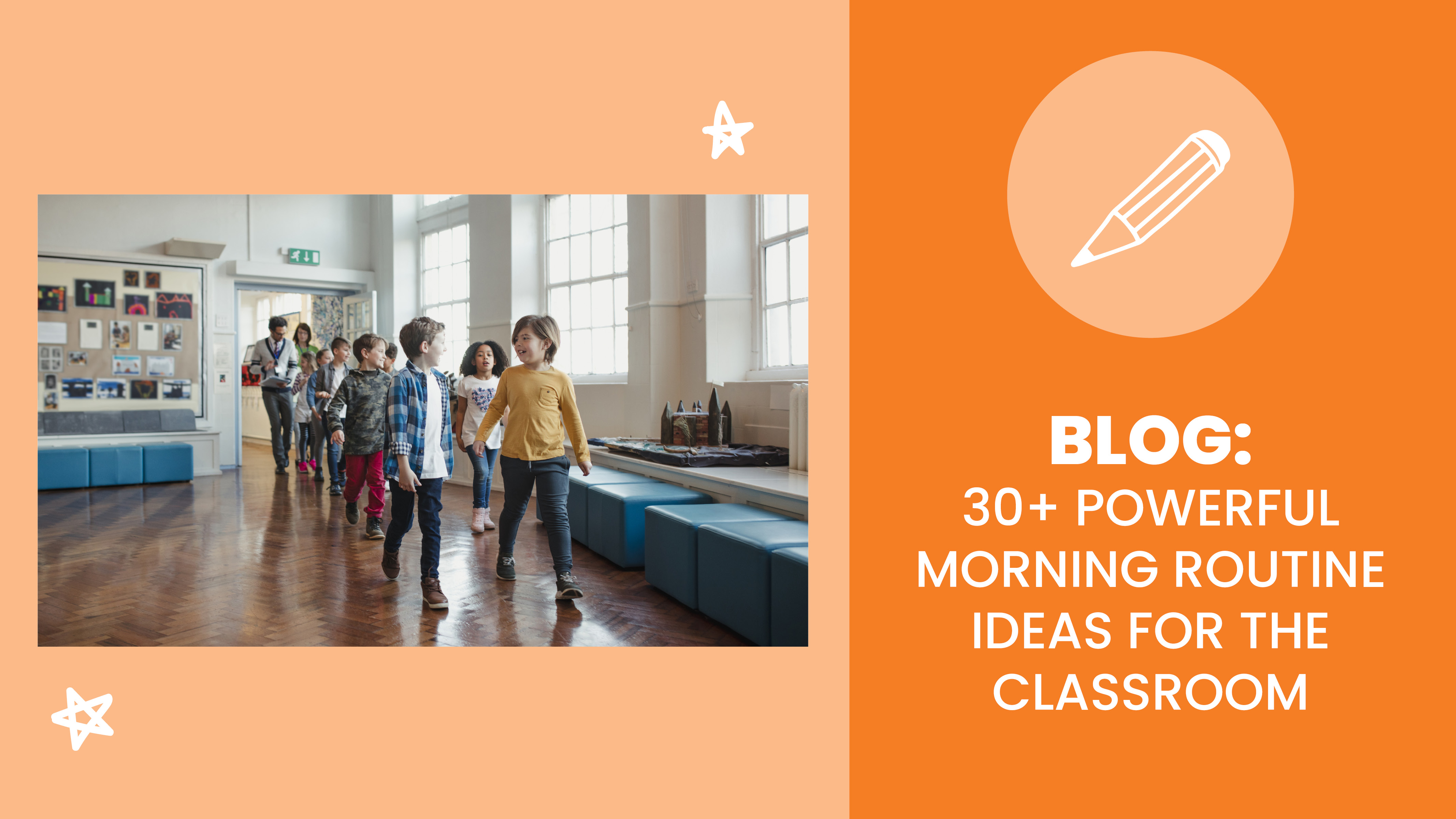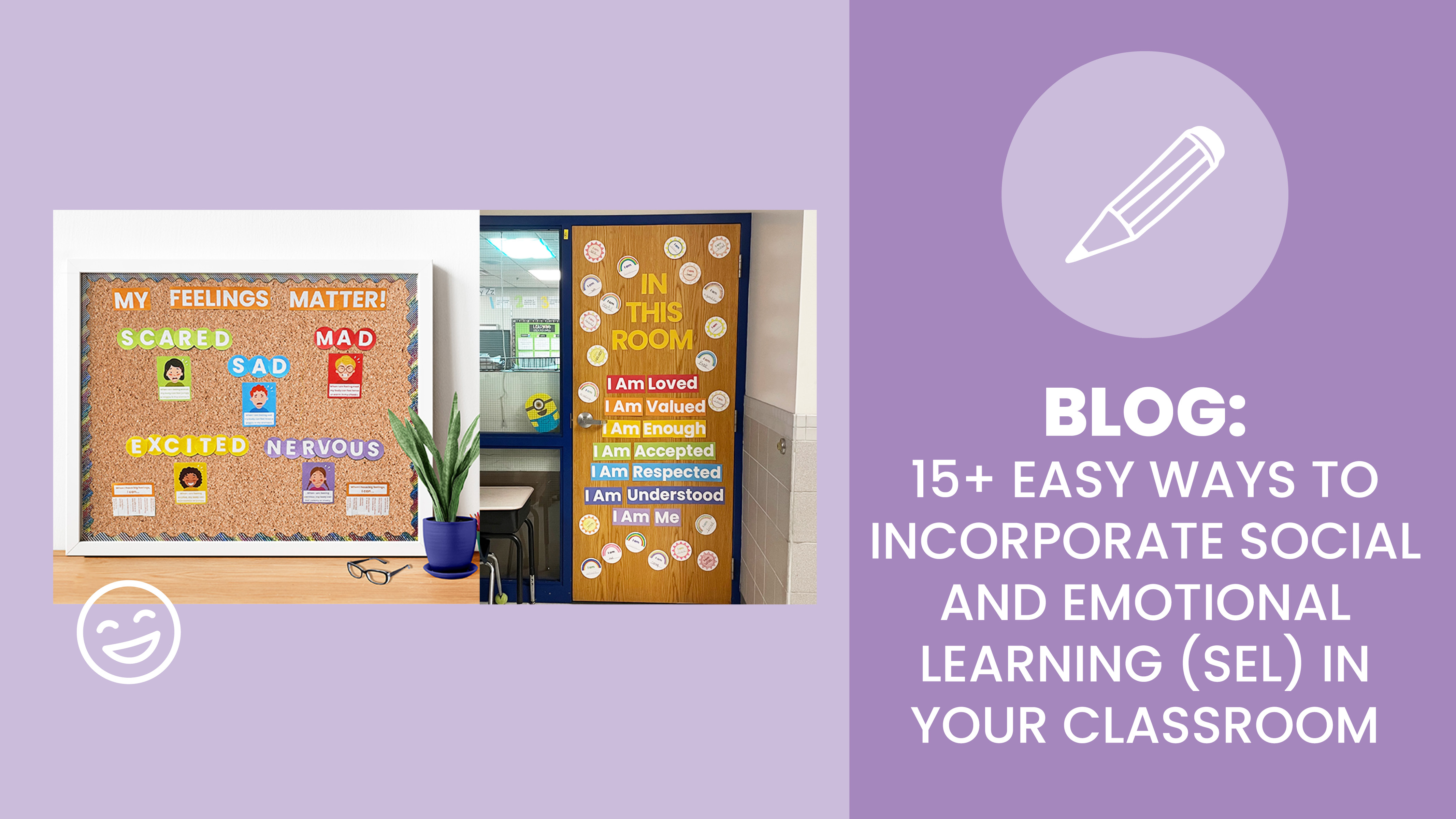As teaching strategies change, innovative technology becomes integrated, and new curriculum evolves, two principles remain constant – the need for classroom management and a sense of belonging. The morning meeting or daily check-in has been around for a long time because it can start your classroom’s day on a positive foot while incorporating educational lessons or teaching students the importance of social and emotional skills like creating positive peer relationships and coping with their feelings. Here are some of our favorites!
Movement and Breathing
- Would you Rather? Talk about healthy choices and get kids moving at the same time! Ask kids, “Would you rather climb a mountain or jump on a trampoline? If you choose mountain climbing, move your body like you’re climbing. If you choose trampoline, move your arms up and down.”
- Groovy Greetings: Short on time?! Ask students to greet 4 other students in a groovy way! Fist or elbow bumps, high fives, pinky shakes, jazz hands, or even an air hug are a few groovy greeting options!
- Rainbow Breaths: This is perfect for the group to do together. Have students stand or sit tall with their arms straight at their sides. As they breathe in, have students move their arms up above their head. As they breathe out, move their arms back down to their sides to make a rainbow shape. Repeat 3 times.
- Star Jumps: This is an easy physical activity that engages the entire body, and you can also modify it for a seated position. Ask students to jump! As they jump into the air, have them reach their arms and legs out to the side, forming the letter X in the air. If seated, eliminate the jump and do Star Arm Raises!
- Whale Breaths: Here’s a new twist on breathing exercises! Ask students to sit tall and take a deep breath in and hold it while you count aloud to 5. Then, ask them to tilt their head up and pretend they’re whales peeking out of the water and then blow all of the air out of their bellies.
- Roll & Move Your Body: Assign a movement to each number on the dice. You can try: 1: Jumping Jacks, 2: Star Jumps, 3: High Knees, 4: Mountain Climbers, 5: Push-ups, 6: Student’s Choice. Each student rolls both dice. The first number rolled is the number of times the student performs the movement, and the second number rolled is the assigned movement. Example: Roll a 4 and a 2. Student performs 4 star jumps and then the next student rolls the dice.
- Have a Ball: Grab a ball and encourage your students to toss it to each other while keeping the ball in the air. As each student catches the ball, you can extend the activity by asking them to spell out a word, name a fruit, or even declare how they feel at that moment. Don’t let the ball touch the ground!
- Indoor Bowling: Fill up 10 water bottles and set them up like pins! Use any ball you have access to and give each student two shots to get a strike. Once they finish their turn, have them choose an action to complete (jumping jacks, bass toss, etc.) as many times as pins they’ve knocked down. This will get their hearts pumping and get their minds focused on the day.
Mindfulness Matters
- Mindful Moments: Choose a mindfulness activity from our free printable Mindful Moments. Use your morning meeting time to practice it together. Some of our favorites include Eye Spy and Rainbow Breathing. Keep the cards handy in your Cozy Corner or on a key ring at your desk.
- Get Grounded: Try a new mindfulness activity as a class. Using the 5-4-3-2-1 method, lead the class through the activity. Ask them to think about 5 things they can see, 4 things they can feel with their body, 3 things they can hear, 2 things they can smell, and 1 thing they can taste. You can ask them to share aloud, too.
- Body Scan: Encourage kids to follow along with you on this mindfulness activity! Invite students to close their eyes and squeeze the muscles in their feet. Have them hold them tight, then release and relax. Next, they can squeeze the muscles in their legs, then release and relax. Keep going for a full-body scan!
- What Smells? Start the day with some deep breathing. Try these follow-along directions: “Take a deep breath through your nose. Pretend you are smelling a flower. With each new breath, pretend there is a new smell!” You can try both pleasant and unpleasant for fun!
Social and Emotional Learning
- Sharing is Caring: Using a social and emotional topic is a great way for kids to strengthen their peer connections and build relationship skills. Try one of these: What makes you a good friend? What are you excited to learn today?
- Weather Report: Check in with your students’ feelings. Name feelings and emotions like happiness, boredom, or calm. Ask students to compare what they are feeling to a weather report! Do they feel cloudy? Sunny? Cold? Practice naming feelings and then use weather to gamify it for students.
- Think, Pair, Share: Use our printable emoji cards for a morning check-in practice. Each student uses their emoji cards to think about how they are feeling and name their emotions. Students pair up with a friend to share their feelings, reflect on their thoughts, and practice listening respectfully to others.
- Practice Coping Strategies: Choose a new coping strategy from our free printable My Keep Cool Cards for each day of the week. Use your morning meeting time to model and practice it together. One of our favorites is “Toss Thought” and “Get Grounded.” Keep the cards handy in your Cozy Corner!
- ASMR Videos (yes, really!): The sensations kids can feel from ASMR mimics many of the feelings they can get as newborns when being comforted by parents. The key to making it educational? Name the feelings! After watching a video, ask students to share how they felt before, during, and after the video.
- Photo of the Day!: Using a photo prompt is a great way to foster interpersonal language skills. Use any photo you like (landscape, pop culture, cartoon) and display it on the whiteboard. Ask students to talk about what they see, how they feel, etc. Once students have had time to talk amongst each other, ask for some group sharing.
- Morning Mindset: Talk to your kids about how they want to feel today. Choose 3-5 words as a group, write them on the board, and use them as affirmations to help your kids remind themselves of the mindsets they want to have for the day.
Use Your Words
- Good Morning Shout-Out: Get everyone involved! Use this phrase, “Good Morning to anyone who _____!” Any student that matches should stand up and wave to the class. Fill in the blank with common phrases that allow all kids to get involved. Examples: loves reading, is wearing red.
- Silly Salutes! Ask students to say hello to each other with silly voices. Try, “Good morning, _____!” in any way you choose. Try one of these ideas: baby, scary, whisper, singing, alien, robot, or puppy. What will the puppy voice sound like?! The options are endless!
- What are You Grateful For? Ask each student to stand up one at a time and share what they are grateful for. If other students are also grateful for that same thing, they can clap their hands together!
- Start with Positive Self-Talk: Practicing positive self-talk as a group is a great way for students to learn the skill and build self-confidence. Try one of these affirmations with a call out and repeat: “I get better every single day! I choose to feel happy!”
- Compliments are for Kids! Each student greets another student and compliments them. You will need to model how to give a compliment and set expectations. For example, talk about compliments that reflect what students do, not what they wear or look like. Example: “You’re very creative!”
- Timed Chatter: Set a timer for two minutes and let your kids get up and talk to each other. The challenge? They have to tell the group ONE thing they remember from the conversations they had. This is a great way to get to know each other and test your students’ memories.
- Build-A-Poem: Encourage each student to pick a word and build a poem out loud as a group! This activity is also a great way to learn about the different kinds of poetry. Can you make a haiku?
It's All Fun and Games
- Funny Fridays: Using age-appropriate humor is a great way to develop communication skills and you can use jokes to introduce a topic. Teaching about health and wellness? Try one to kick off the day: Why did the pillow go to the doctor? He was feeling all stuffed up!
- Secret Student: Choose one student to be a “secret student” for the day. Give a hint about who that student is in the morning and after lunch then let the students guess who the “secret student” is at the end of the day!
- It’s the Color Game! Stand or sit in a circle and the teacher begins the game by calling out a color. Everyone who is wearing that color has to switch places with someone else who is also wearing that color. Do the same activity using favorite foods or games and activities!
- Play the Name Game! Have each student say their name for the group and then say their favorite fruit or veggie. The next student will repeat what the previous student just said, and then answer for themselves. With older students, you can have them say a positive word that starts with the same first letter as their name. (Ex: Caroline – Courageous)
- Food Fun Facts: Encourage each student to learn one fun fact about their favorite fruit or vegetable and share it with the group! Example: Almonds are a member of the rose family. This means that almonds and peaches are related!
Ready for More? You May Also Like:
It’s a Good Day for a Good Day! – Door Kit Printable


